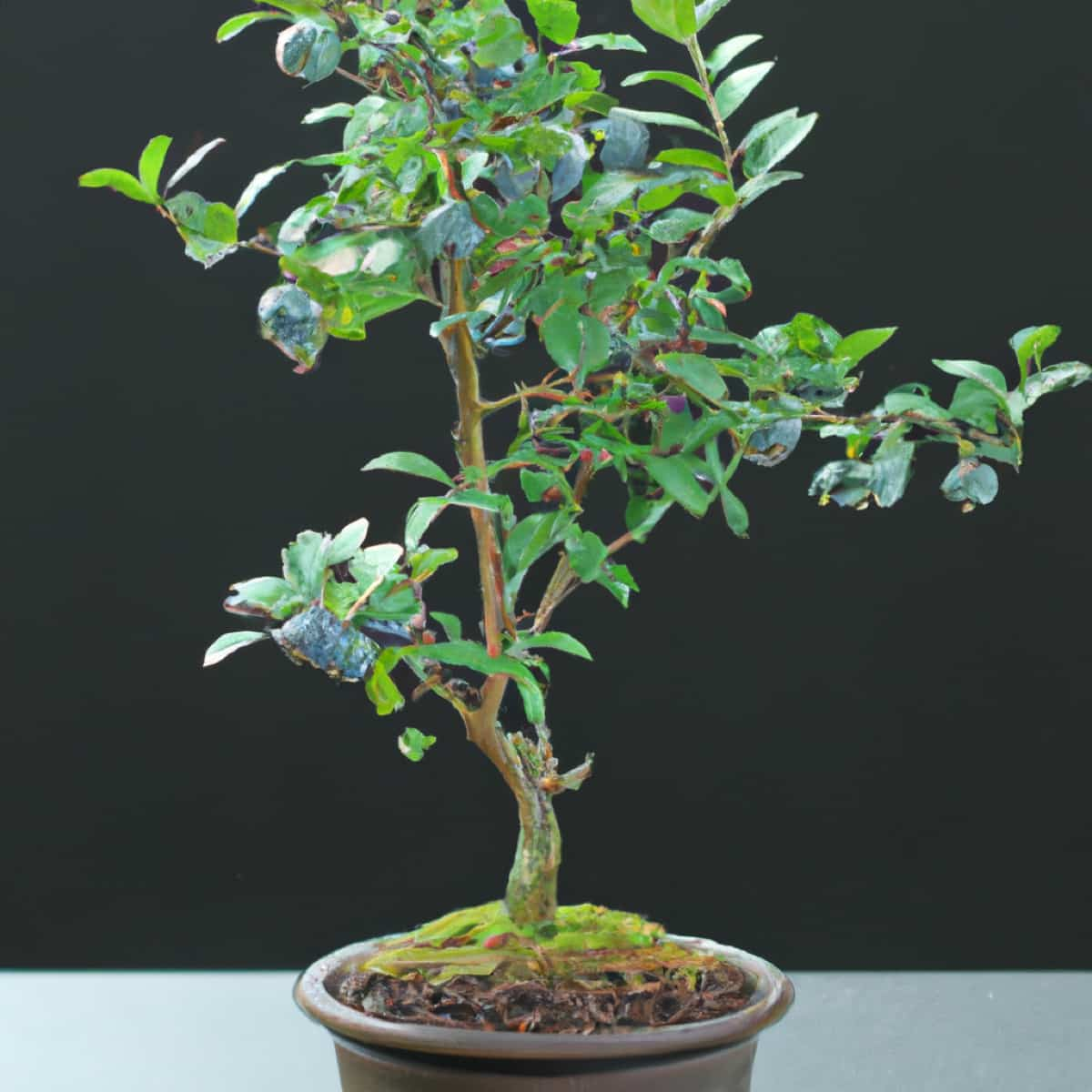There is something truly mesmerizing about Bonsai trees. These miniature wonders capture the imagination, transforming any space into a peaceful haven of natural beauty. The blueberry Bonsai, in particular, stands out due to its beautiful flowers, enticing fruits, and vibrant leaves, making it a highly sought-after species among enthusiasts. However, growing and maintaining these miniature marvels is a delicate art that requires patience, attention, and specific techniques.

Here we learn from choosing the right Bonsai blueberry tree to preparing the soil, planting, watering, fertilizing, pruning, shaping, protecting it from pests and diseases, providing adequate sunlight, and maintaining the right temperature and humidity. Let’s also explore the crucial task of repotting and some best practices for Bonsai blueberry care.
How to Grow and Care for Blueberry Bonsai
Choosing the Right Bonsai Blueberry Tree
The journey to owning a flourishing Bonsai blueberry tree starts with choosing the right specimen. A young, healthy plant is crucial for success, as it has the vigor and resilience to adapt to Bonsai training. When purchasing your Bonsai blueberry, look for vibrant foliage, the absence of pests and diseases, and plump, juicy blueberries. A great place to find a Bonsai blueberry tree is at local nurseries, farmers’ markets, or specialized Bonsai shops.
Preparing the Soil for Bonsai Blueberry
One of the best conditions for Bonsai blueberry is well-drained, slightly acidic soil. Preparing the perfect soil mix can be as much of an art as shaping the tree itself. It’s essential to strike the right balance between water retention, aeration, and nutrition. A typical soil mix for Bonsai blueberries includes a blend of Akadama, pumice, and organic compost. Akadama is a hard, baked Japanese clay, excellent for water retention and aeration. Pumice aids with drainage, and organic compost provides the necessary nutrients. The blend provides the perfect conditions for blueberry roots to flourish.
Planting Bonsai Blueberry Tree in a Container
Planting a Bonsai blueberry tree in a container involves more than just placing it in soil. First, select a pot that complements the size and style of your Bonsai. Bonsai pots are usually shallow and come in various shapes and sizes. They also have drainage holes to prevent water-logging. Before planting, prune the roots to maintain the tree’s small size and enhance its overall health. Place the tree in the pot and cover the roots with the prepared soil. Ensure the tree is firmly anchored but not compacted, which could hinder root growth.
Watering Techniques for Bonsai Blueberry
Watering is a crucial aspect of blueberry Bonsai care. Unlike typical plants, Bonsai cannot be watered on a set schedule. They require close observation to determine when they need water. A well-watered Bonsai blueberry should have damp but not waterlogged soil. Water your Bonsai thoroughly, ensuring the water flows out of the drainage holes. The watering frequency depends on several factors, such as the size of the pot, the type of soil, and the weather.
In case you missed it: Hydroponic Blueberry Farming in a Greenhouse: Key Rules to Start from Scratch

Fertilizing Bonsai Blueberry Tree
Bonsai trees live in small amounts of soil and rely heavily on fertilization for nutrients. As such, fertilizing is vital to your blueberry Bonsai care routine. Use a balanced Bonsai fertilizer or an acid-loving plant fertilizer to nourish your Bonsai blueberry. Apply the fertilizer during the growing season, typically from spring to early autumn. However, avoid fertilizing a few weeks before repotting, as this can damage the newly trimmed roots.
Pruning and Shaping Bonsai Blueberry
The essence of Bonsai lies in its aesthetics. Pruning and shaping your Bonsai blueberry tree give it the desired miniature tree look. Prune your tree during its dormant period, typically in late winter or early spring. Use clean, sharp shears to cut away dead or overgrown branches. Pruning directs plant energy towards healthy growth. Shaping involves directing the tree’s growth to achieve a certain look. This is often done using Bonsai wire, carefully wrapped around the branches and trunk. Over time, the tree grows into the desired shape.
Protecting Bonsai Blueberry From Pests and Diseases
Like all plants, Bonsai blueberries can be susceptible to pests and diseases. Regularly inspect your tree for signs of trouble, such as discolored leaves, wilting, or unusual growth. Common pests include aphids, mites, and caterpillars. If you spot any, use a gentle insecticidal soap or neem oil spray to deal with them. Diseases like root rot or fungus can be prevented by ensuring good ventilation, avoiding overwatering, and maintaining clean conditions. If your Bonsai does contract a disease, consult a local garden center or Bonsai expert for treatment advice.
Providing Adequate Sunlight for Bonsai Blueberry
Sunlight is vital for the growth and fruiting of Bonsai blueberries. These trees thrive in full sun but can tolerate partial shade. Place your Bonsai in a south-facing window or a sunny spot in your garden. You might need to consider supplemental light sources if you live in a less sunny area. However, avoid the harsh afternoon sun, which can cause the leaves to scorch.
Maintaining Temperature and Humidity for Bonsai Blueberry
Bonsai blueberries are temperate plants and thrive in moderate climates. They thrive in diverse temperatures. However, it’s important to avoid extreme temperatures. During winter, protect your Bonsai from harsh frosts. Humidity is also vital for Bonsai blueberries, especially during the warmer months. Use a humidity tray with water and pebbles to raise the humidity around your Bonsai pot.
Repotting Bonsai Blueberry Tree
Repotting is an essential aspect of Bonsai care. As Bonsai trees grow, their roots can become bound within the confines of the pot, which can restrict their growth and health. Therefore, regular repotting is usually necessary every two to three years. The best time to repot a Bonsai blueberry tree is in late winter or early spring, before the onset of new growth. To repot, delicately take the tree out of its pot, trim the roots, refill the soil, and put the tree back in its container.
In case you missed it: The Best Fertilizer for Blueberries: When and How to Apply

Conclusion
Cultivating a Bonsai blueberry tree is a labor of love and dedication. It requires constant care, precise techniques, and attention to detail. However, the reward of seeing your Bonsai thrive and bear fruit is indeed unparalleled. Whether you’re a seasoned horticulturist or a novice plant enthusiast, this guide provides the knowledge to grow and care for your Bonsai blueberry tree. So, are you ready to embark on this rewarding journey?
- Feed Your Flock for Less: Top 10 Tips to Save on Chicken Feed
- Ultimate Guide to Ossabaw Island Hog: Breeding, Raising, Diet, and Care
- Hatching Answers: The Top 10 Reasons Your Chickens Aren’t Laying Eggs
- Eggs and Economics: Breaking Down the Cost of Raising Backyard Chickens
- Defend Your Greens: Proven Methods to Keep Iguanas Out of Your Garden
- Ultimate Guide to Cinnamon Queen Chicken: A Comprehensive Guide for Beginners
- Ultimate Guide to California Tan Chicken: Breeding, Raising, Diet, Egg-Production and Care
- Ultimate Guide to Marsh Daisy Chicken: Breeding, Raising, Diet, and Care
- 10 Types of Chicken Farming Businesses You Can Start for Profits